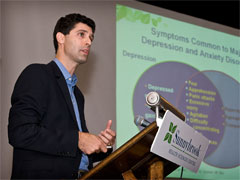A Distinction too Rare
By Jim Oldfield
In 2007, Dr. Ayal Schaffer, an associate scientist at Sunnybrook Research Institute, uncovered a disturbing treatment pattern in patients with bipolar disorder. He found that Canadians with the disease—which his earlier work suggested number 500,000—were more likely to be on antidepressants than on any other medication.
The discovery was worrying because research shows that antidepressants taken without a mood stabilizer can make bipolar disorder worse by inducing mania (mood elevation) and pushing patients toward the up-and-down mood extremes that make the disease so debilitating.
Today, while some psychiatrists have limited antidepressant prescriptions for bipolar patients in favour of alternatives like mood stabilizers, many family doctors—the physicians from whom most bipolar patients receive initial treatment—are still prescribing them commonly.
Why? Bipolar patients are often misdiagnosed with depression, and treatment of depression calls for antidepressants.
Distinguishing bipolar disorder and depression presents challenges
"It's tricky to differentiate between the two," says Schaffer, who is also an associate professor at the University of Toronto. Many bipolar patients spend considerable time in the depressed phase of the illness without showing signs of mania. Moreover, he says, establishing an accurate diagnosis is a time-intensive process. Family physicians have multiple patients waiting and only a few minutes to spend with each; thus, they tend to avoid the full psychiatric assessment that might illuminate the disorder.
Although U.S. researchers have documented the misreading of depression and bipolar symptoms for two decades, Schaffer's study hinted at another problem. More than one-half the bipolar patients he looked at, and almost an equal percentage of those with depression, had anxiety. Doctors, he reasoned, were either prioritizing anxiety or making it the primary diagnosis, both of which can also lead to antidepressant therapy.
Anxiety, while concerning on its own, can also be a sign of bipolar disorder; that's why Schaffer is now working to incorporate anxiety and other risk factors into a tool that will help physicians diagnose the illness better. In addition to anxiety and mania, disease onset in childhood or adolescence, and suicidal thoughts or attempts can increase a person's risk for bipolar disorder; Schaffer plans to publish a complete set of predictors later this year.
Predictors enable probabilistic approach to diagnosis
Once stratified, Schaffer says, these predictors "ideally will be used to help family doctors or psychiatrists identify those people with depression who are more likely to have an underlying bipolar disorder." Schaffer points to cardiac screening as an example: a person walks into the emergency department with chest pain; the doctor may spend a couple minutes asking about the pain, but a lot of time investigating risk factors for heart disease. If the patient is 65 years old, smokes, has diabetes and cholesterol, then he will be viewed very differently than someone with the same pain symptoms who is aged 21 years with no history of trouble. "It's a probabilistic model that fits with other areas of medicine," says Schaffer. "In psychiatry, beyond family history, we've rarely talked about other predictors of bipolar disorder."
This oversight has inhibited progress in a disease that is not only a grim experience for patients, but that brings lasting psychosocial and medical consequences.
Still, Schaffer is optimistic. Better diagnoses will lead to improved outcomes, and about two-thirds of bipolar patients will eventually be symptom-free with only intermittent relapses, or will be fully stable. "Is it hard to see people go through it? Absolutely," says Schaffer. "But because we have tools and an understanding of what to do, it's a very exciting and satisfying area to work in."
The Canadian Institutes of Health Research and the Ontario Mental Health Foundation funded Schaffer's work.
PDF / View full media release »





